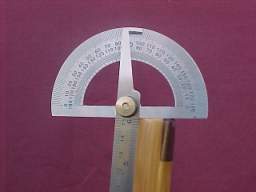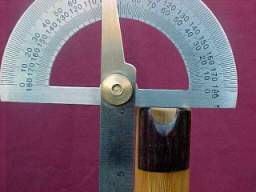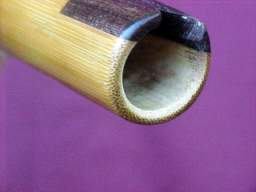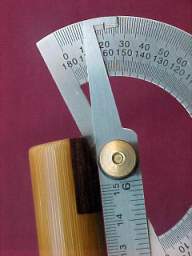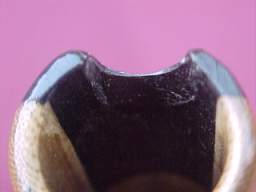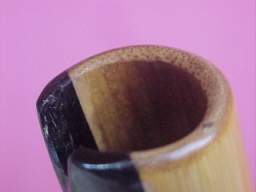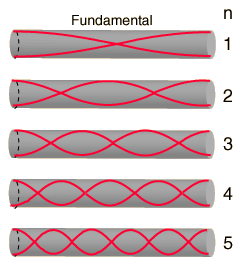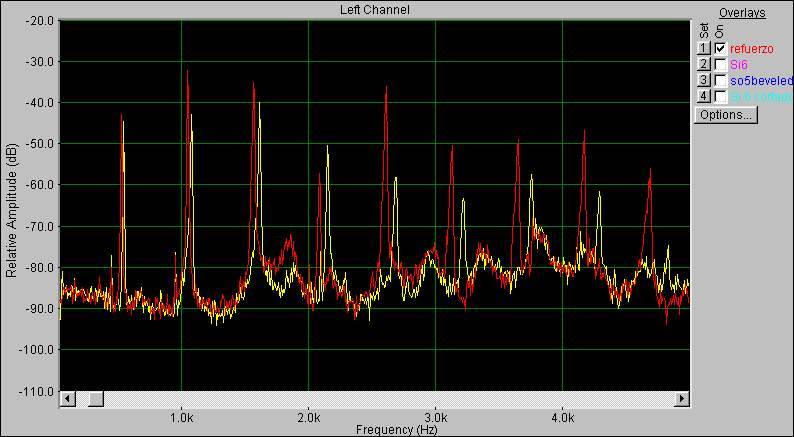SELECTING A QUENA - ADVICE
and some
quenamaking items updated May 30th 2010 |
||||||||||||||||||||||||
By
Angel Sampedro del Rio
Text revised by Karl DeLong If you do not wish to read the full article, here is a summary to select your quena.
Diameters are measured at the embouchure end, when the bore is a constant diameter. Tapered bores –common in bamboo tubes- should be measured at the average diameter. These measurements should be considered as relative to other quena features. Additional comments on diameter and embouchure are given below: Two characteristics make one quena different than another: the diameter of the bore and the type of embouchure (the notch close to the mouth). Together these two elements contribute to the playability of the instrument. Different quenas have diverse sound characteristics. Larger diameter quenas (18mm-20mm) produce a heavier sound, reinforcing low frequencies, while thinner ones (16 to 18mm) give agile and easy access to overtones. They are good for beginners because they demand less air. The main characteristic of the notch is its area. This area determines an acoustical property called the “additional length” of the air column (and is important in determining the frequency). The bigger this area is, the higher the frequency of all notes (other factors being equal). This is useful to adjust the main pitch of the instrument –say, the 440 Hz A- when fine tuning. There are two basic measuremenets of notches: width and depth.
Width is the tangential dimension, and to some extent determines how wide you can blow. A wider notch allows a wider jet that can carry more flow, and thus how much air you can use to get a louder sound. Depth is the distance between the lip’s gap and the receiving edge. It is measured longitudinally with respect to the instrument and also, to some extent, determines how fast you have to blow and the mass of air involved. We can distinguish big and small notches by their area, which determines how much vibrational internal air (called stationary wave) is exposed to external air, to build the travelling sound waves outside the instrument. Other factors being equal, the bigger the notch the more the surface is exposed, the more the loudness (a rough approximation, since other flute elements may work in opposition). Two quenas with notches that expose the same area (being other factors equal) would have the same frequency, but timbre and spontaneity might be quite different if notches are different in width or depth. The influence of the embouchure is also affected by the external and internal angle of the notch. The angle of the upper end of the quena relative to the quena line and embouchure cut-down (see photos below). To play a quena –as well as other winds, a musician must control either the air jet speed, the precision (the aim – I mean here to be a good shot) and the volume of air involved. A good quenista might blow at great speed using more or less volume of air to control the loudness (dynamic range) and fine pitch of the instrument (bending). A deep notch makes the quena louder, but also more difficult to play because the jet must reach the edge travelling a longer distance. It is so because the edge is far from the lips, and will demand either more precision (the same as shoot to a target at 100 m rather than 10 m), and more speed . Depending on how the player blows, the pitch may be slightly altered. To explain this from an acoustical point of view, the sound of flutes is due to an oscilator connected to a resonator. The first element is the air jet reaching a sharp edge (the same principle is found in transverse flutes, quenas, recorders, pinkuyos, organ pipes, etc). The sound frequency of each note is altered by the speed of the jet and the distance between the lips to the receiving edge (by slight differences in covering the opening). The frequency also depends on the position of the instrument relative to player's mouth. Every wind instrument allows some "bending" in pitch, and used properly it allows many subtleties in playing. As a general rule, the bigger the diameter the greater the bending Small notches allow less bending and modulation, so these instruments are easier to play in tune. But, otherwise, they get less volume and intensity. This might be an advantage for a beginner, but also some great players prefer these embouchures. A problem here is that the jet must be more precisely directed when the notch is narrower. Also, very small notches might introduce a great constriction in the air flow, resulting in an octave stretch (high notes sharp). Bending the pitch is a good thing when you do it by intention, used as an expressive tool of musical language. But is terrible when that means that you can't control the pitch! Is common to call quenas divided in “duras” and “blandas” (literally, hard and soft), referring to the spontaneous response. Supposedly beginners need a soft one but even an experienced musician can be benefited by an instrument that is easy to play. As a general rule, a quena with a greater bore diameter will demand more air from the player, and will be louder. A big (in area) notch does the same. The angle of the upper end of the quena relative to the quena line
, as well as the angle and position of the notch into the wall also affect the playability and comfort of the quena. The thickness of wall also plays a role here by restricting the air movement so that the manner in which the notch is carved (the ammount on the inside or outside) will affect the sound.
This restriction is not necessarily bad. Some air molecules that otherwise would go to open air, are redirected to the edge by wall thickness. This is mainly observed in externally carved notches, and is not noticed at all by begginers. But properly used by an experienced musician, it gets a richer sound in low notes by enhacing overtones, producing a louder and richer tone. This is because the breaking limit of overblowing might be pulled farther -the musician can blow harder without changing the register, especially in the lowest octave (first mode of vibration). Below, the Spectral analysis of this effect (FFT -Fast Fourier Transformed) Players might feel more comfortable with one or another notch's shape, the most common shapes being V or U, and occasionally squared. For all the above statements, the size of the notch relative to the diameter and tapering of the quena is an important factor in flutemaking. In our opinion, a wide U-shaped notch is the one that contributes to a great dynamic range and loudness, as well as a good intonation. The explanation is that a great part of the audible sound produced by the quena comes from the notch that, being bigger, will enhance it. Our U-shaped embouchures, also, allow the lips to be less far form the blowing edge, thus avoiding "hardening" of the blow (I mean the effort given by the musician in blowing), and being wide, less precision of blowing is necessary. Also, this width allows better control of the dynamic range.
With regard to the real size of the notch, it is dependent on the diameter of the instrument, but not in a linear way. The diameter of the air column is also dependent on the length (key) of the flute to keep the same tonal quality. But the air flow, lip gap’s shape and size, lung volume of the player remain constant, no matter which instrument is played. So, we found that is not good advice to “project” all the measures (depth and width) when the internal diameter is changed. I mean here that if you make a longer instrument, you should take into account that things relative to player (lips, lung, etc) remain unchanged (or almost unchanged). For example, if you make an instrument in a key that is the double of lenght, you mustn't double the diameter or notch measures. And, even if you doubling the diameter of the instrument, must not double the size of the notch.
Playability is also conditioned by the shape of the bore and its "harmonicity" (that is, how different vibrational modes cooperate each other on the sound). Evaluation of this aspect, specially in high quality quenas, is an important and specific work of the flutemaker Another important factor is the good finishing and conception of the instrument. A well-rounded, edgeless instrument, without rough nor sharp parts, is much more practical for playing. Sometimes quenas are well- finished to the eye, but the maker didn't take into account the end of the instrument in contact with player's face, with 90 degrees angles that, sooner or later, avoid a good performance.
Finishing Toneholes and ends, Why apply a finishing? Good finishing of a tonehole is not only more comfortable, but also prevents future cracks in the instrument. In bamboo, the most moisture circulation between the walls and external air is longitudinal, considering that the fibers (vascular bundles) go in that direction. So, for durability, it is advisable to cover these parts and so delay the wet-drying process. Our quenas are sealed by immersion. Thus, the inner wall of the instrument is protected. This sealing doesn't inhibit the perspiration of the wood, but makes it slower. Sealant is a nitro cellulosic lacquer with some additive like very fine pumice stone. This shuts all small pores and gives a very smooth surface to apply the nitro lacquer that gives the final protection by an elastic layer. We developed the recipe both for lacquer and sealant used for immersion. Lacquering is also done by immersion. With that we unsure that the external and internal tubes, the ends and the tonehole rims are covered and protected. This sealing and lacquering also has an acoustical effect. There are different points of view about the pros and cons of the internal treatment of the tube, but none of these treatments have a negative effect on sound. Sealer tends to cover small pores in the wall, reducing the friction (resistance) of the movement of air molecules. In practice, we observed differences in the same quena before and after the sealing process. The result is a clearer sound and a more spontaneous response. This phenomenon is similar, but maybe less noticeable, to cleaning and oiling the bore of a recorder. Once it is cleaned and oiled, the volume and sonority are changed (the value of oiling is also debated among flutemakers). We have even observed an enhancement on playability of high or very high notes, once the tube is lacquered. High quality quenas Embouchures made with a hard wood inlay are especially lasting, since they prevent humidity changes in a crucial part of the instrument. Further, they are hardly lacquered. But the main goal of making hardwood embouchures is to re-evaluate the whole instrument, and subtlety change some of the features described above (angles, width, depth, total area, cut-down, fine shape) that, carefully managed, optimize the resultant instrument
More of our best quenas and accesories
For
more information or prices, email us
info@unmundodebambu.com.ar
|
||||||||||||||||||||||||
